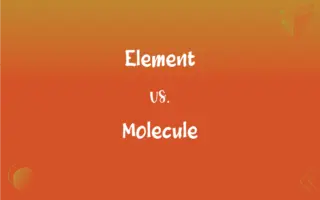Tungsten Carbide vs. Boron Carbide: What's the Difference?
Edited by Janet White || By Harlon Moss || Published on January 22, 2024
Tungsten carbide is a hard, dense metal compound used for cutting tools and abrasion resistance, whereas boron carbide is a lighter, extremely hard ceramic used in ballistic armor and abrasive applications.

Key Differences
Tungsten carbide, a compound of tungsten and carbon, is known for its extreme hardness and high melting point, making it ideal for cutting and drilling tools. Boron carbide, a compound of boron and carbon, also boasts extreme hardness but is lighter, lending its use in lightweight ballistic armor.
In terms of density, tungsten carbide is significantly heavier, which is beneficial in industries requiring heavy-duty tooling. Boron carbide's lower density makes it preferable for applications where weight is a critical factor, like in body armor.
The manufacturing processes of tungsten carbide often involve powder metallurgy, while boron carbide is typically produced through carbothermal reduction. Both processes are complex and require precise control.
Tungsten carbide is known for its wear resistance, making it a top choice for industrial applications subjected to high wear and tear. Boron carbide, while also wear-resistant, is more renowned for its ability to absorb impacts, hence its use in protective gear.
In terms of cost, tungsten carbide is generally more affordable and widely used in various industries, whereas boron carbide's specialized applications, particularly in defense and aerospace, make it a more expensive material.
ADVERTISEMENT
Comparison Chart
Composition
Tungsten and carbon
Boron and carbon
Density
Heavier, dense
Lighter, less dense
Primary Use
Cutting tools, drilling, abrasion resistance
Ballistic armor, abrasive applications
Manufacturing Process
Powder metallurgy
Carbothermal reduction
Cost
Generally more affordable
More expensive due to specialized applications
ADVERTISEMENT
Tungsten Carbide and Boron Carbide Definitions
Tungsten Carbide
A hard compound of tungsten and carbon.
Tungsten carbide is used in making durable drill bits.
Boron Carbide
Ceramic material used in defensive armor.
Boron carbide plates provide protection in combat helmets.
Tungsten Carbide
A metal compound used in industrial tooling.
Tungsten carbide is favored for high-stress machinery parts.
Boron Carbide
An abrasive material in industrial applications.
Boron carbide nozzles are used for abrasive blasting.
Tungsten Carbide
Substance with a high melting point.
Tungsten carbide remains stable under high-temperature conditions.
Boron Carbide
A compound known for its impact absorption.
Boron carbide is used in aerospace for its strength-to-weight ratio.
Tungsten Carbide
Material known for its extreme hardness.
The tungsten carbide tips extend the life of cutting tools.
Boron Carbide
A lightweight, extremely hard ceramic.
Boron carbide is integral to modern ballistic vests.
Tungsten Carbide
A dense, wear-resistant material.
Tungsten carbide coatings protect against abrasion.
Boron Carbide
High-hardness ceramic with specialized uses.
Boron carbide is utilized in nuclear reactors due to its neutron absorption properties.
FAQs
What are the primary applications of boron carbide?
In ballistic armor and abrasive materials.
What is tungsten carbide?
A hard compound of tungsten and carbon.
Is tungsten carbide heavier than boron carbide?
Yes, tungsten carbide is denser and heavier.
Where is tungsten carbide commonly used?
In cutting tools, abrasives, and industrial machinery.
Why is boron carbide used in body armor?
For its light weight and high impact resistance.
Is boron carbide more expensive than tungsten carbide?
Generally, yes, due to its specialized applications.
What is boron carbide?
A lightweight, extremely hard ceramic material.
Can boron carbide absorb neutrons?
Yes, it's used in nuclear applications for neutron absorption.
Can boron carbide withstand high temperatures?
Yes, it has good thermal stability.
Can tungsten carbide resist high temperatures?
Yes, it has a high melting point and thermal stability.
How is tungsten carbide manufactured?
Typically through powder metallurgy.
What makes tungsten carbide so hard?
Its crystalline structure and the strength of tungsten-carbon bonds.
Is tungsten carbide safe for skin contact?
Yes, it's hypoallergenic and safe for most people.
Is tungsten carbide magnetic?
It is generally considered to be non-magnetic.
Does tungsten carbide corrode easily?
No, it's highly resistant to corrosion.
What manufacturing process is used for boron carbide?
Carbothermal reduction is commonly used.
How does boron carbide compare to diamond in hardness?
It's one of the hardest materials after diamond.
Is tungsten carbide used in jewelry?
Yes, for its durability and scratch resistance.
Are there any environmental concerns with boron carbide?
Its production and disposal should be managed responsibly.
What are the limitations of using boron carbide?
Its cost and brittleness in certain applications.
About Author
Written by
Harlon MossHarlon is a seasoned quality moderator and accomplished content writer for Difference Wiki. An alumnus of the prestigious University of California, he earned his degree in Computer Science. Leveraging his academic background, Harlon brings a meticulous and informed perspective to his work, ensuring content accuracy and excellence.
Edited by
Janet WhiteJanet White has been an esteemed writer and blogger for Difference Wiki. Holding a Master's degree in Science and Medical Journalism from the prestigious Boston University, she has consistently demonstrated her expertise and passion for her field. When she's not immersed in her work, Janet relishes her time exercising, delving into a good book, and cherishing moments with friends and family.






































































